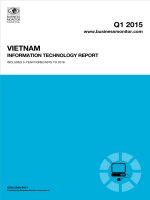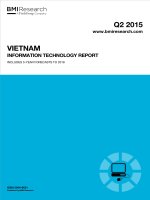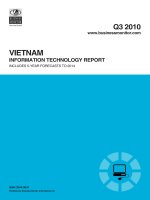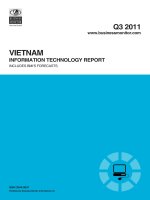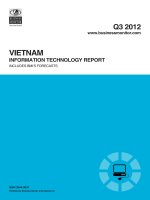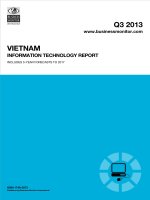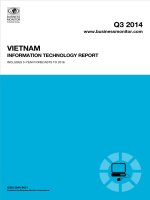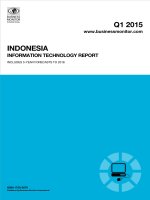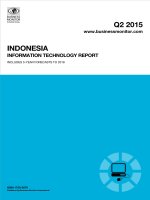United states information technology report q3 2015
Bạn đang xem bản rút gọn của tài liệu. Xem và tải ngay bản đầy đủ của tài liệu tại đây (429.42 KB, 98 trang )
Q3 2015
www.bmiresearch.com
UNITED STATES
INFORMATION TECHNOLOGY REPORT
INCLUDES 5-YEAR FORECASTS TO 2019
ISSN 2042-4205
Published by:BMI Research
United States Information Technology
Report Q3 2015
INCLUDES 5-YEAR FORECASTS TO 2019
Part of BMI’s Industry Report & Forecasts Series
Published by: BMI Research
Copy deadline: June 2015
BMI Research
Senator House
85 Queen Victoria Street
London
EC4V 4AB
United Kingdom
Tel: +44 (0) 20 7248 0468
Fax: +44 (0) 20 7248 0467
Email:
Web:
© 2015 Business Monitor International Ltd
All rights reserved.
All information contained in this publication is
copyrighted in the name of Business Monitor
International Ltd, and as such no part of this
publication may be reproduced, repackaged,
redistributed, resold in whole or in any part, or used
in any form or by any means graphic, electronic or
mechanical, including photocopying, recording,
taping, or by information storage or retrieval, or by
any other means, without the express written consent
of the publisher.
DISCLAIMER
All information contained in this publication has been researched and compiled from sources believed to be accurate and reliable at the time of
publishing. However, in view of the natural scope for human and/or mechanical error, either at source or during production, Business Monitor
International Ltd accepts no liability whatsoever for any loss or damage resulting from errors, inaccuracies or omissions affecting any part of the
publication. All information is provided without warranty, and Business Monitor International Ltd makes no representation of warranty of any kind
as to the accuracy or completeness of any information hereto contained.
CONTENTS
BMI Industry View 7
SWOT 9
IT SWOT 9
Political 11
Economic 12
Operational Risk 13
Industry Forecast 14
Table: IT Industry - Historical Data And Forecasts (United States 2012-2019) 14
Macroeconomic Forecasts 20
Economic Activity 20
Industry Risk Reward Index 25
Table: Americas IT Risk/Reward Index, Q315 28
Market Overview 29
Hardware 29
Software 37
Services 43
Industry Trends And Developments 48
Regulatory Development 54
Table: IT Regulatory Authorities 54
Competitive Landscape 56
Local Companies 56
Table: CA Technologies 56
Table: EMC Corporation 57
Table: Splunk 58
Table: Symantec 59
Company Profile 60
Dell 60
Hewlett-Packard 66
Table: Hewlett-Packard Financial Performance By Division: 70
IBM 73
Table: IBM Major Acquisitions, 2012-2014 75
Microsoft Corporation 79
Regional Overview 86
Americas 86
United States Information Technology Report Q3 2015
© Business Monitor International Ltd Page 4
Demographic Forecast 88
Table: Population Headline Indicators (United States 1990-2025) 89
Table: Key Population Ratios (United States 1990-2025) 89
Table: Urban/Rural Population & Life Expectancy (United States 1990-2025) 90
Table: Population By Age Group (United States 1990-2025) 90
Table: Population By Age Group % (United States 1990-2025) 91
Methodology 93
Industry Forecast Methodology 93
Sources 94
Risk/Reward Index Methodology 95
Table: It Risk/Reward Index Indicators 96
Table: Weighting Of Components 97
United States Information Technology Report Q3 2015
© Business Monitor International Ltd Page 5
BMI Industry View
BMI View: The outlook for US IT spending remains strong when compared to the majority of developed
markets over the medium term, as a result of stronger economic performance and a greater interest from
enterprises in the latest products and solutions. Cloud computing, real-time enterprise software, security
and big data are all areas of spending in which we expect to see strong growth, particularly in the latter
years of our forecast. The retail hardware outlook is more mixed, as we expect continued demand growth
for tablets in the retail market; however, desktop and notebook sales continue to be squeezed. Total
spending is expected to reach USD680.7bn in 2015, up 4.8% from 2014, and grow at a CAGR of 3.4%
2015-2019.
Headline Expenditure Projections:
■
Computer Hardware Sales: USD216.3bn in 2014 to USD222.9bn in 2015, an increase of 3.0%. Tablet
volumes set to decline, but at a slower rate than 2014, while traditional form factors are expected to
continue gaining ground after steep declines in 2012 and 2013.
■
Software Sales: USD181.2bn in 2014 to USD190.6bn in 2015, an increase of 5.2%. Enterprise software-
as-a-service adoption has strong momentum, while demand for cyber security solutions is also an area of
growth.
■
IT Services Sales: USD251.9bn in 2014 to USD267.3bn in 2015, an increase of 6.1%. Cloud computing
adoption is already high in the US but we expect strong growth to continue over the medium term despite
security concerns following on from the National Security Agency (NSA) Prism debacle.
Key Trends And Developments: One major development with only limited importance for the US IT
market but huge ramifications for US cloud providers was the New York District Court ruling in August
2014 that Microsoft must hand over customer data stored in its Dublin datacentre due to the fact it is a US
company. Microsoft refused and is challenging the ruling for fears it would undermine confidence in US
providers, which is already fragile following the overreach of the Patriot Act and Edward Snowden
revelations about NSA activities. Microsoft's case argues US government cannot reach across international
borders and retrieve data without respecting local privacy laws. The position held by Microsoft has been
shown to be supported by local populations outside the US, leaving difficult questions about the case
unanswered at the time of writing. BMI believes a large number of US vendors with international
operations will be concerned with the case due to the large loss of confidence in the US legal system and
foreign policy in the past two years.
Regulatory issues aside, a significant trend in the cloud market has been the increased utilisation of
partnerships between leading providers. In June 2014, Microsoft and Salesforce.com entered a partnership
United States Information Technology Report Q3 2015
© Business Monitor International Ltd Page 7
agreement, while in October 2014 Microsoft and IBM announced a partnership agreement to focus on
hybrid cloud solutions. In March 2015, Microsoft also entered into a partnership with Cisco Systems to
integrate their cloud services. The new service will combine Microsoft's Windows Azure Pack, which forms
the Windows cloud architecture, with Cisco's ACI, which provides the networking services layer. BMI
believes the developing set of partnerships and collaborations reflects the increasing maturity of the cloud
market and vendor plans for interoperability of services to enable future growth of complex deployments.
United States Information Technology Report Q3 2015
© Business Monitor International Ltd Page 8
SWOT
IT SWOT
SWOT Analysis
Strengths
■
The largest IT market in the world, with spending forecast to reach
about USD805.0bn in 2019.
■
The US is the largest centre of global IT innovation, home to many leading hardware,
software and services vendors.
■
Meanwhile most non-US global firms also have a research and retail presence.
■
Despite the challenging trading conditions, overall IT spending is still expected to
remain in positive growth territory.
Weaknesses
■
In the wake of the recession and subsequent slow economic recovery, customers
have postponed IT investments and reduced short-term spending, particularly in
areas such as consulting and software development.
■
Desktop and notebook sales appear to be in long-term decline due to longer
replacement cycles and the preference for mobile devices including tablets,
smartphones, smart TVs and convertibles/hybrids.
Opportunities
■
Technologically-savvy local population willing to spend on premium devices, with the
US a particularly strong market for Apple's iPad and MacBooks.
■
As economic conditions strengthen, IT vendors should see more growth from
traditional big-spending sectors such as banks, financial services, retail and
manufacturing.
■
Potential for growth in the hardware market through form factor evolution; ie, ultra-
thin notebooks, hybrids/convertibles and tablets.
■
Cloud computing, with a large number of federal and state cloud computing
programmes generating opportunities.
United States Information Technology Report Q3 2015
© Business Monitor International Ltd Page 9
SWOT Analysis - Continued
■
Growth from emerging technologies such as big data and machine-to-machine
communications will drive innovation and spending.
Threats
■
Privacy and cybersecurity became more pressing issues with the PRISM spying
revelations. This is expected to damage US cloud computing providers abroad, but
domestic impact is uncertain.
■
The large federal budget deficit could lead to pressures on public sector IT spending.
United States Information Technology Report Q3 2015
© Business Monitor International Ltd Page 10
Political
Political SWOT Analysis
Strengths
■
The US is an undisputed superpower and therefore occupies centre stage in most
international diplomacy.
■
A long-standing democracy with vigorous and open political debate, the US
continues to attract large numbers of immigrants committed to citizenship and self-
advancement.
Weaknesses
■
Political debate between Republicans and Democrats has historically been polarised
and divisive.
■
As today's superpower, the US attracts the enmity of a wide range of political groups
opposed to the current international status quo.
Opportunities
■
The widespread dissatisfaction of the voting public with the performance of Congress
may encourage both major parties to experiment with more consensual approaches
to certain policy areas.
Threats
■
The perception of inflexibility and bias in US foreign policy, particularly in the Middle
East, may stiffen opposition and at worst provide fertile recruiting ground for radical
anti-US groups such as al-Qaeda. Partly as a reaction to foreign policy difficulties, US
public opinion may return to an isolationist and protectionist mode.
■
Compromise is becoming increasingly difficult in domestic politics, and gridlock on
spending issues could prompt another government shutdown, or even drive the US to
a default on its debt.
United States Information Technology Report Q3 2015
© Business Monitor International Ltd Page 11
Economic
Economic SWOT Analysis
Strengths
■
The world's largest economy, with an impressive record of entrepreneurial dynamism
and innovation, and high research and development spending.
■
Despite some threats to its reserve status, the US dollar is treated as an international
currency, meaning investors around the world are prepared to hold US debt. Because
of this, the US is uniquely able to run large fiscal and current account deficits.
Weaknesses
■
Despite the dollar's role as an international currency, excessive US debt levels are a
risk. A decision by the Japanese and Chinese central banks to reduce their larger
dollar holdings could cause sharp falls in the value of the US currency.
■
A low savings rate by US households on a historic basis, although this has begun to
reverse.
Opportunities
■
Further liberalisation of international trade through the WTO, coupled with a more
competitive dollar exchange rate, could boost export growth and help address the
US's external imbalances.
Threats
■
Intensified competition from China and other low-wage economies could accelerate
the loss of manufacturing jobs.
■
Long-term budget imbalances, if left unaddressed, could eventually require an abrupt
cut back in spending that would weigh on economic growth.
United States Information Technology Report Q3 2015
© Business Monitor International Ltd Page 12
Operational Risk
SWOT Analysis
Strengths
■
The US boasts the world's largest single internal consumer market, which presents
tremendous opportunities for businesses of all types and sizes.
■
Few countries offer a better environment for entrepreneurial activity, with a highly
flexible labour force, a legal system that is friendly to business, and significant centres
of technological innovation (such as California's Silicon Valley).
Weaknesses
■
Much of the physical infrastructure is in need of improvement, with congested roads
and airways.
■
US corporate tax is, on average, among the highest in the OECD (though effective
taxes are much lower).
Opportunities
■
The US has often been the origin of new drivers of economic growth booms, and
sectors ranging from biotechnology to alternative energy are being discussed as
possible catalysts.
Threats
■
The US's chronic fiscal deficits may force the federal government to find ways to raise
effective corporate tax rates, following a multi-decade downtrend.
United States Information Technology Report Q3 2015
© Business Monitor International Ltd Page 13
Industry Forecast
Table: IT Industry - Historical Data And Forecasts (United States 2012-2019)
2012 2013 2014e 2015f 2016f 2017f 2018f 2019f
IT market value,
USDmn
595,113.6 620,346.4 649,316.6 680,678.6 710,628.5 740,403.8 774,536.4 805,363.0
Computer hardware
sales, USDmn
206,837.6 211,414.1 216,287.4 222,854.2 227,898.6 232,486.8 238,015.0 242,092.1
Personal computer
sales, USDmn
167,331.6 172,513.9 177,139.4 182,629.0 187,332.6 191,220.4 196,124.4 199,847.0
Software sales,
USDmn
161,573.3 171,234.3 181,159.3 190,569.5 200,354.5 210,207.8 221,424.2 231,823.4
Services sales,
USDmn
226,702.7 237,698.1 251,869.9 267,254.9 282,375.5 297,709.2 315,097.2 331,447.5
IT market value, % of
GDP
3.7 3.7 3.7 3.7 3.7 3.7 3.7 3.7
e/f = BMI estimate/forecast. Source: BMI
BMI forecasts US IT market growth will accelerate slightly to 4.8% in 2015 to reach a value of
USD680.7bn as stronger economic growth raises enterprise and consumer confidence. We expect IT market
growth will remain robust considering the maturity of the US market, with a compound annual growth rate
(CAGR) of 3.4% forecast for 2015-2019, and total spending expected to reach USD805.4bn in 2019.
Despite the maturity of the IT market in the US, we believe there is medium-term growth potential in sales
of hybrid notebooks in the retail market, while in the enterprise market adoption of cloud computing, big
data and the internet of things (IoT) will drive growth.
2015 Outlook: IT market spending growth in 2014 was limited by economic conditions and a decline in
tablet volumes due to market saturation after large numbers of first-time buyers entered the market
2011-2013. However, both these limitations are expected to ease in 2015, underpinning acceleration from
4.7% growth in 2014 to 4.8% in 2015. The acceleration would have been stronger but for the fact that the
withdrawal of Microsoft support for XP in April 2014 brought forward some enterprise hardware and
software upgrade demand from 2015.
US IT market growth will be sustained in 2015 by the supportive economic environment. When compared
with its developed market peers, the US market is expected to continue to perform well. US economic
United States Information Technology Report Q3 2015
© Business Monitor International Ltd Page 14
growth for 2015 is forecast at 2.9% in real terms (up from 2.3% in 2014), while private final consumption is
also forecast to grow slightly faster at 2.6% (up from 2.5% in 2014).
The hardware market will be the underperforming segment of the IT market in terms of growth rates in
2015. The maturity of the market in terms of desktop, notebook and tablet penetration means first-time
buyer opportunities are scarce for vendors, and sales are concentrated in the replacement market. Further,
due to the rapid diffusion of tablet ownership and subsequent lengthening of replacement cycles in 2014, we
expect volumes will once again decline in 2015, down from a peak in 2013 when there were more than
50mn first-time buyers. However, areas of growth in 2015 are expected to be demand for hybrid notebooks
and Chromebooks.
IT Market Growth
2012-2019
United States - IT market value, USDmn
2012 2013 2014e 2015f 2016f 2017f 2018f 2019f
0
1,000,000
250,000
500,000
750,000
e/f = BMI estimate/forecast. Source: BMI
Overall, there will continue to be a squeeze on public sector IT spending, but growth will continue for cloud
services, for which there are expected to be many more contracts with the continued implementation of the
federal government of its Cloud First cloud migration strategy. Departments such as the US General
Services Administration are already making significant use of cloud services, as the government seeks to
United States Information Technology Report Q3 2015
© Business Monitor International Ltd Page 15
make savings in its USD80bn IT budget. The recession may have had a lasting impact on the IT market by
encouraging consideration of cloud computing models such as software-as-a-service (SaaS).
The strongest outlook is for enterprise spending on IT in 2015. BMI expects spending will accelerate in
2015 as confidence begins to return. However, while there is pent-up demand from projects delayed as a
result of the economic situation, some of this may now be abandoned or reconsidered. The growing market
for cloud solutions and virtualisation will constrain demand for on-premises computer networks. Regardless
of the exact strength and nature of the recovery, the current economic environment will offer some
opportunities to vendors.
Drivers: The economy will be generally supportive over the medium term, particularly when compared to
other developed markets. Real GDP growth is forecast to average 2.5% annually 2015-2019, with
consumption growth expected to be slightly slower at 2.3%. Meanwhile, BMI's in-house Country Risk
team's income stratification forecast for the US shows that the gains will largely be captured by the highest
earning 10% of the population, while incomes for the remaining 90% are expected to see only slow growth.
This bodes well for vendors of premium hardware including Apple, which targets its PC devices at the
highest earners, but the outlook for sales growth of mid-range devices is mixed, particularly in the context
of market maturity.
United States Information Technology Report Q3 2015
© Business Monitor International Ltd Page 16
Income Per Capita Breakdown
(2012-2019)
Poorest 20%, net income per capita, USD
Richest 20%, net income per capita, USD
Middle 60% of population, net income per capita, USD
2012 2013e 2014e 2015f 2016f 2017f 2018f 2019f
-25,000
0
25,000
50,000
75,000
100,000
e/f = BMI estimate/forecast. Source: BMI
Investments in supporting infrastructure will boost IT market spending over the medium term. Telecom
operator investments in mobile and fixed broadband infrastructure will help to boost retail sales of
hardware, particularly mobile PCs such as tablets and hybrids/convertibles. These investments also enable
adoption of cloud computing services by consumers and small- and medium-sized enterprises (SMEs) that
are not in large urban areas already served by high-quality telecoms infrastructure.
There are also technology trends that will drive growth. BMI has a bullish view for the development of the
machine-to-machine communications (M2M) market, or IoT, which is a medium-/long-term opportunity for
IT software and service providers to partner with telecoms operators. In 2013, leading software and services
firms, including SAP and Wipro, partnered with M2M communications providers to tap growth in the
nascent market. US mobile operators are among the global leaders in the deployment of M2M services, with
verticals such as utilities, security, asset tracking, vehicle infotainment and other smart services targets for
growth. We believe software and services firms will benefit either through partnerships with operators or by
selling to them direct.
United States Information Technology Report Q3 2015
© Business Monitor International Ltd Page 17
Another technology trend is the adoption of cloud computing services, with surveys showing high levels of
satisfaction with cloud services among US chief information officers, reflecting the fact it is already the
world's leading cloud market. This means growth opportunities are relatively diminished compared to
emerging markets, but vendors will drive value growth by rolling out more customised solutions and
targeting SMEs.
Segments: The government remains a key consumer despite pressure on expenditure. New government
programmes, including the expansion of healthcare, should generate lucrative new opportunities for IT
vendors, although there will be increased pressure to reduce costs because of the budget deficit.
US GVA By Vertical (%)
2015f
f = BMI forecast. Source: National statistics, World Bank, UN, BMI
With real economic growth now underway, IT vendors should experience more growth from traditionally
big-spending sectors such as banking, financial services, retail and manufacturing. BMI expects financial
services will be a key spending vertical as new regulations require increased investment, and in addition, the
increasing cybersecurity threat facing them will force further investment in services and solutions. The
advent of mobile payment systems will be an additional source of spending growth.
United States Information Technology Report Q3 2015
© Business Monitor International Ltd Page 18
Small businesses are also a target for vendors. There are more than 8mn small businesses in the US, which
is a substantial market. However, there are significant differences between the needs of businesses in
different industries. Increasingly, vendors will need to customise approaches based on industry-specific
needs.
Summary: The hardware market is predicted to grow from USD216.3bn in 2014 to USD242.1bn in 2019.
Software spending should rise from USD181.2bn to USD231.8bn, and IT services from USD251.9bn to
USD331.4bn, over the forecast period (2015-2019).
United States Information Technology Report Q3 2015
© Business Monitor International Ltd Page 19
Macroeconomic Forecasts
Economic Activity
BMI View: Real GDP growth in the US will accelerate in the coming years, on the back of stronger private
consumption and low borrowing costs. We forecast headline growth of 2.9% in 2015 and 2.6% in 2016, up
from 2.4% in 2014.
The US economy will grow at a faster pace in 2015 and 2016, with real GDP expanding by 2.9% and 2.6%
over those two years respectively, compared to the 2.4% seen in 2014. The main driver of this growth will
be the private sector, with household consumption bolstered by lower inflation, improved labour market,
and low borrowing costs. Investment will be bolstered by low interest rates, and by government initiatives
to expand transport infrastructure. These factors will help to offset the headwinds associated with a strong
US dollar, which will weigh on net exports.
Growth To Pick Up
Real GDP Growth, % chg y-o-y
2008 2009 2010 2011 2012 2013 2014 2015f 2016f
-4
-2
0
2
4
f = BMI forecast. Source: BEA, BMI
United States Information Technology Report Q3 2015
© Business Monitor International Ltd Page 20
Expenditure Breakdown
Private Consumption: The outlook for the consumer sector continues to improve, as unemployment
maintains its broad downward trajectory (coming in at 5.5% in March). Although other indicators have been
less encouraging (nonfarm payrolls increased by only 126,000 in March, while labour force participation
remains at multi-decade lows), overall we expect that compared to 2014, the labour market will be
significantly improved. Household consumption levels will be further supported by an uptick in personal
income levels, which have grown by an average of 4.5% year-on-year (y-o-y) over the first two months of
2015, compared to an average of 3.9% over the course of 2014.
Perhaps even more significantly, consumer price inflation has fallen to the lowest levels seen since 2009,
due in large part to the collapse in the price of oil, which has contributed to much lower fuel costs. As
consumers spend less at the fuel pump, they will benefit from greater discretionary income for other goods,
leading to an increase in consumption in real terms. Furthermore, following a major deleveraging cycle in
the wake of the financial crisis of 2008-2009, consumers are beginning to borrow to a greater extent. With
borrowing costs likely to remain extremely low over the coming quarters, we expect this trend to remain in
place.
United States Information Technology Report Q3 2015
© Business Monitor International Ltd Page 21
Low Price Growth Will Support Consumption
US - Inflation, % chg y-o-y
Source: Bloomberg
Gross Fixed Capital Formation: Private fixed investment was among the strongest drivers of growth in
2014, expanding by 5.3% in real terms, and we expect that amid low interest rates and broadly improving
economic conditions, this trend will continue in 2015 and 2016, particularly for long-term investments.
Indeed, non-residential structures grew by 8.1% in real terms in 2014, among the strongest growth rates
seen across all segments of the economy, due to fundamental factors we believe will remain in play over the
coming quarters. Residential investment growth rates were more subdued, but we ascribe this to statistical
base effects, due to double-digit expansion in both 2012 and 2013.
Net Exports: Import demand has risen significantly in recent quarters, due to both the greater purchasing
power of consumers described above, as well as the multiyear US dollar bull run which has made imported
goods more affordable. Although US monetary policy will remain loose by historical standards, the Fed will
embark on a tightening cycle well ahead of other major central banks, including in Japan and Europe,
meaning that dollar strength will remain a theme in 2015 and 2016. Apart from bolstering imports, this will
also weigh on US export competitiveness, producing significant headwinds for autos and aircraft
manufacturers. Finally, the steep decline in the price of oil will weigh on US producers' margins, and reduce
United States Information Technology Report Q3 2015
© Business Monitor International Ltd Page 22
the pace of domestic energy production expansion over the next several quarters, potentially requiring
greater volumes of fuel imports. As a result, although the nominal trade balance will improve, the real trade
balance faces headwinds.
Government Consumption And Investment: We anticipate that lawmakers will seek to relax the
constraints on expenditures put in place following the 2011 debt ceiling debate. As a result, spending will
begin to pick up in 2015, following four consecutive years of spending declines, although, political pressure
to maintain fiscal discipline will limit the scope of this change. We expect that defence expenditures will
pick back up, as President Barack Obama's efforts to address threats in Iraq and other parts of the Middle
East are accommodated by Republicans' efforts to restore military spending.
Transport Investment Expansion To Continue
US - Transport Construction Spending, Public And Private, USDbn
Source: US Census Bureau
Meanwhile, we expect a revival in public sector investment into transport infrastructure, a key component
of our generally constructive view towards US infrastructure. In 2014, transportation spending from federal,
state, and local sources increased by 4.0% y-o-y, a significant figure considering 90% of US transport
United States Information Technology Report Q3 2015
© Business Monitor International Ltd Page 23
investment comes from public sources. With growing bipartisan support for infrastructure spending, we
expect this trend to continue in the years ahead.
Risks To Outlook
Our growth outlook assumes low borrowing costs, low oil prices, and a strong dollar, all of which will
support private consumption in the coming quarters. If any of these assumptions do not play out (for
example, due to a more aggressive tightening cycle by the Fed than expected, or a significant escalation of
violence in oil-producing regions in the Middle East), we would have to revisit our forecasts. Furthermore,
if low job creation data in March proves the beginning of a longer-term trend of slack in the labour market,
we would likely revise our view on household spending.
United States Information Technology Report Q3 2015
© Business Monitor International Ltd Page 24
Industry Risk Reward Index
BMI View: The medium-term outlook for the Americas' IT market has stabilised in the wake of telecoms
and business environment reforms that benefit Mexico and Argentina in particular. These two countries
rapidly ascended our IT Risk/Reward Index for Q315, overtaking politically and economically challenged
Brazil. The bigger picture reveals similar headwinds that will further separate the highest and lowest
scoring markets.
Strong GDP and GDP growth support the USA and Canada's leadership positions and the 10 points between
these markets and third-ranked Mexico highlight the distinction between IT prospects across the Americas
region. Although Mexico's position has improved, its businesses and households are less likely to be
connected or make regular use of technology than seen in the developed IT markets in North America.
These two markets pull up the regional average for the IT Index. The average for the Latin American
markets alone is 55.5, a full 4.3 points below the total region.
The US and Canadian markets are particularly reliant on the services industries to drive economic growth.
These industries are increasingly reliant on IT services and platforms to improve efficiencies and will
continue to generate strong opportunities. Economic and political turmoil arguably has less of an influence
in these developed markets as services are already online and used by the majority of the population.
Mexico has always outperformed the Latin America Risk/Reward Index (RRI) average principally due to its
size. Its greatest weakness has been the dominance of a few players in the telecoms market that have made
online access very difficult. However, reforms offer long-term potential as connectivity is fundamental to
the expansion of the IT market. As it pushes above the regional average and overtakes Brazil and Chile
(previously the top markets in the region), the opportunities in Mexico are highlighted, particularly as it
catches up to its more developed rivals. While we do not expect Mexico to match the scores of the top two
markets, wider improvements across the region will result in a narrowing of the divide.
United States Information Technology Report Q3 2015
© Business Monitor International Ltd Page 25
